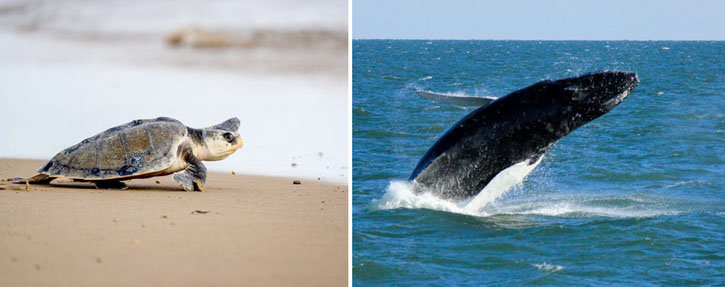Rachel Carson Country
The ocean is a place of paradoxes. It is the home of the hundred-foot blue whale, the largest animal that ever lived. It is also the home of living things so small that your two hands might scoop up as many of them as there are stars in the Milky Way.
— Rachel Carson, “Undersea.”
For as long as my family has lived in Virginia, I have, as often as I can, committed to the windows-down, progressively flatter drive from Richmond to the sloping coasts of “Rachel Carson country.”
 Sandbridge is the secret seed stuck between two well-known beach vacation front teeth. It is aptly named, a shifting connection sitting just south of the Norfolk naval bases and just north of the Outer Banks (OBX) of North Carolina, the sandbar beach strip that inspired a popular Netflix series mostly filmed in Charleston, SC. Depending on the season, observant beachgoers can spot hundreds of species of seabirds, sea turtles, ducks, dolphins, and, if you’re really lucky, whales.
Sandbridge is the secret seed stuck between two well-known beach vacation front teeth. It is aptly named, a shifting connection sitting just south of the Norfolk naval bases and just north of the Outer Banks (OBX) of North Carolina, the sandbar beach strip that inspired a popular Netflix series mostly filmed in Charleston, SC. Depending on the season, observant beachgoers can spot hundreds of species of seabirds, sea turtles, ducks, dolphins, and, if you’re really lucky, whales.
In late February, I made the four-hour drive from UNC’s campus to Sandbridge, to my secret seed, to watch the sunset and run from the icy tide when it licked at my ankles. I knew that I would bundle up to kayak the sound, gliding around grassy corners to sneak up on fiddler crabs and Great Blue Herons. I knew that I would walk the gravel trails of the Back Bay National Wildlife Refuge just up to the point where they are closed for the winter, out of respect for the tundra swan and snow geese nests. I did not know that a few days before my arrival, a whale, the fourth of the season, had washed ashore just north of my happy place.
On February 12th, a North Atlantic right whale was found dead on the beach some 30 miles north, at Virginia Beach. This species, named for their tendency to float once killed (the “right” whales to hunt), is severely endangered. From my own research, and the hearsay bumping around Little Island Pier between casts, only around a few hundred remain. The whale was a 20-year-old male over forty feet long, and the cause of death was deemed blunt force trauma, likely a ship strike. The fishermen were quieter than normal that evening – the waves, too.
Since December first of last year, 22 whales have stranded along the Atlantic coast. Fifteen humpbacks, three sperm whales, two North Atlantic right whales, one sei whale, and one minke whale have been stumbled upon, lifeless. According to NOAA and the buzz of Sandbridge residents, whale deaths so far in 2023 are already rivaling last year’s totals.
What is most pressing is that no one is quite sure why these whales are dying so frequently. An unusual Mortality Event (UME) was declared in 2016, and continues through this year. Even so, 2023 has been an especially steep increase in the number of whale bodies dotting the coastlines between Maine and Miami.
In early January, I stumbled upon a woman dragging two basset hounds down the beach, their ears digging ant trails in the wet sand. We stopped to chat and compare shark teeth treasures, as two passing beachcombers often do. She grew up in Sandbridge, and was especially concerned with the strandings, citing the grief she felt the high tide brought in with the whale bodies. Among her circles, the blame fell on offshore wind energy projects that overlap with the areas experiencing the most whale strandings. The energy projects involve ocean floor mapping with powerful devices to scout locations for energy facilities and cable lines. NOAA has denied that wind farm equipment is at all involved in the whale deaths, because the tools are smaller and quieter than the tools used in offshore oil and gas exploration. Thus far, there is no evidence to support these claims.
Some experts attribute the higher death numbers to larger Humpback whale populations in general, or a higher prevalence of Atlantic menhaden, a small, silvery fish that have been hanging around the North Atlantic coast for longer than usual, keeping their predators around as well. Others blame warming waters and current changes that lead to shifted migration patterns of potential food sources. Most, though, agree that a combination of factors are likely at play, but vessel strikes and entanglements pose the greatest risks to whale species, endangered or not. Of the 88 humpback whales that have washed up on the Atlantic coast in the past three years, about 40% of necropsies revealed evidence of ship strike or entanglement.
 According to the pier fishermen and the beachcomber alike, as well as the consensus I have found among experts, the most promising local policy change proposes to try to reduce ship strike mortalities through a reduction in the speed limits contained in the North Atlantic right whale vessel speed rule. The changes widen boundaries and timing of seasonal speed restrictions designed to slow boats of different sizes during essential migration times of the right whale population. They just might slow the vessels enough for the sailors to catch sight of a flickering tail and a trailing little one. At least, that’s what I hope.
According to the pier fishermen and the beachcomber alike, as well as the consensus I have found among experts, the most promising local policy change proposes to try to reduce ship strike mortalities through a reduction in the speed limits contained in the North Atlantic right whale vessel speed rule. The changes widen boundaries and timing of seasonal speed restrictions designed to slow boats of different sizes during essential migration times of the right whale population. They just might slow the vessels enough for the sailors to catch sight of a flickering tail and a trailing little one. At least, that’s what I hope.
When I walk the coasts of Sandbridge, just a few hundred miles up the coastline, I am not surprised that Rachel Carson found poetry in this environment. Pods of dolphins travel up and down the coastline, passing each other like whistling ships. The waves oscillate in intensity – what could pull your surfboard out from under you in the afternoon is glassy calm and deceptively peaceful by sunrise. Maybe it has to do with what they carry. They peak joyfully and barrel over when a whale tail or two breach the surface past the horizon line where the sun melts into a mirage. Maybe they slow, lapping sorrowfully at my ankles when they carry heavy bodies and roll them onto the beach to show us what we have done, and what we will continue to do if we don’t slow down
— RCC Presidential Fellow Molly Herring
 RCC Presidential Fellow — Molly Herring — University of North Carolina, Chapel Hill
RCC Presidential Fellow — Molly Herring — University of North Carolina, Chapel Hill
RCC Presidential Fellow Molly Herring is a senior at the University of North Carolina, Chapel Hill pursuing a double major in Biology and Global Studies with a minor in Creative Nonfiction. Molly was born in the North Carolina Appalachian Mountains and raised between Richmond and the beaches of Sandbridge, Virginia, but has journaled from the kitchen tables and living room floors of host families all over the world. She has been published in Oceanographic Magazine, Coastal Review, The Marine Diaries, and Cellar Door. She currently assists research in sea turtle geomagnetic self-location mechanisms in the Lohmann Lab at UNC and works in communications for the UNC Center of Galapagos Studies. Molly straps on a SCUBA tank whenever she can.






